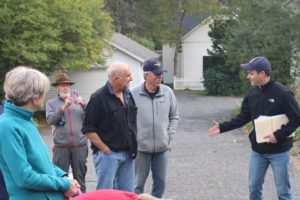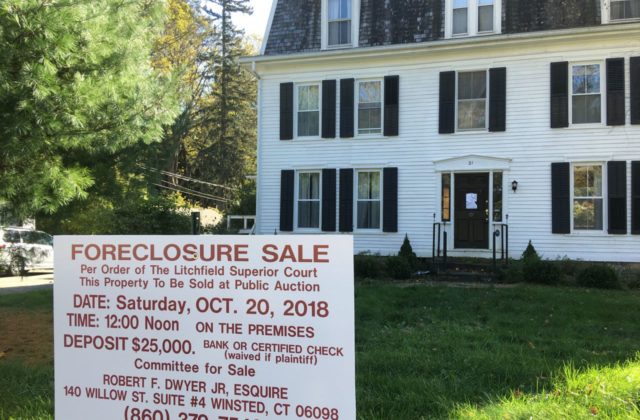Landmark on Village Green Bought by Bank
Fate of building uncertain after years of neglect
By Wiley Wood

Robert F. Dwyer, right, conducted the auction on the court’s behalf.
Crissey Place, the square, mansard-roofed house that has anchored the southeast corner of the village green for more than two centuries, went on the auction block on Saturday, Oct. 20, at noon. Derelict since its former owner, Peter Vosburgh, entered Geer Village Senior Community in 2016, and reportedly seeping water at windows and chimneys, the building was in foreclosure. A court-appointed attorney, Robert F. Dwyer, conducted the on-site auction. With the noon bell still ringing in the steeple across the green, Dwyer announced that the bank was making an opening bid of $235,000. “Sorry, but the bank decided to buy the building back,” said Dwyer. No further bids were tendered, and the proceedings closed.
As recently as 2016, the nine-bedroom, four-bath house on .6 acres was valued at $480,000, but a recent court-ordered appraisal set its value at $140,000, with necessary repairs and renovations in excess of $500,000. A small group of Norfolk residents met recently to discuss the building’s possible future, according to Barry Webber, executive director of the Norfolk Historical Society, but were divided in their opinions. “Half thought it should be saved,” said Webber, “and half thought it should be taken down.”
The house is admired for its landmark presence on the village green, its historical status as one of Norfolk’s earliest buildings and its hybrid architecture—the original 18th-century structure was renovated in Second Empire style by a prosperous late 19th-century owner. When Marie Kendall climbed to the steeple of the Congregational Church to photograph the aftermath of the blizzard of 1888, Crissey Place, standing recognizably across the road from Battell House, already had its trademark mansard roof and cupola.
The bank’s buyback of the building was normal and expected, said Vosburgh’s lawyer, Michael Sconyers, who was present at the auction. Vosburgh had a reverse annuity mortgage on the house, an arrangement where an elderly owner assigns ownership of his house to the bank upon his death in return for a lump sum or monthly payments. When Vosburgh took up residence at Geer Village, however, the building was foreclosed on, said Sconyers. An auction scheduled for 2017 had to be canceled when the action was improperly served on Vosburgh’s son in California rather than on Vosburgh himself.
According to Dwyer, the bank is likely to relist the house for sale within the next six months.
“The bad news,” says Webber, “is that the house will sit through the winter empty and unprotected again.” Webber toured the house in 2016 with Gregory Farmer, a circuit rider for the Connecticut Trust for Historic Preservation, who noted in an email that the house is listed in the National Register of Historic Places and is included in the Norfolk Local Historic District. Any demolition or significant exterior alteration of the property, wrote Farmer, would require the approval of the Norfolk Historic District Commission, and any “unreasonable destruction” of the property could be challenged under the Connecticut Environmental Protection Act (CEPA).
The immediate task, said Farmer, is to find a new owner and a compatible use for the property. He pointed out that state and federal tax incentives are available for the rehabilitation of historic houses.
“But it will take money,” said Webber.

